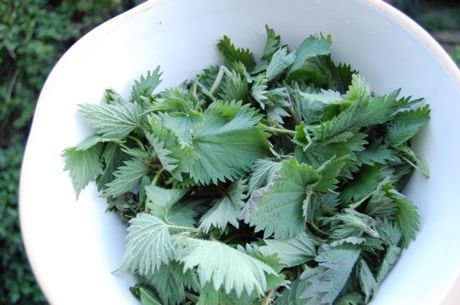Nettle’s botanical name Urtica dioica comes from the Latin “uro” meaning “I burn”. Nettles have tiny hairs on their leaves and it is these hairs that cause the stinging sensation on human skin. However, the leaves and roots of this potent plant have been used for millennia as a medicinal herb, an edible vegetable, and a strong material for making clothes.
For aches and pains
Today, people use nettles for a wide range of healing, from prostate health through to lactation aid, energy tonic to natural allergy support. A recent study at the University of Plymouth revealed that stings from nettles significantly reduced pain in 85% of arthritis sufferers studied. Though there is a long history of nettles being used for musculoskeletal pain, it now seems the medical world is taking notice. The Alternative Medicine Review states that nettles may help with low back pain, sciatica, sprains, chronic tendonitis and osteoarthritis.
A tonic for the blood
Anaemia has also been successfully treated with nettles, as the leaves contain a high amount of iron. Nettles are renowned for their affinity with the blood, with the leaves containing a large amount of chlorophyll, similar in chemical structure to haemoglobin. To increase the haemoglobin count, they make an excellent tonic for athletes. Drinking nettle tea can be useful for those with diabetes, because they help to regulate blood sugar.
Immunity, allergies and a healthy urinary system
Nettles are also well known for their use with diseases of the urinary system, including prostate problems, infections, inflammations, bed-wetting and incontinence. They are often used when people are detoxing, because of their cleansing effect and support of the liver and spleen. For those troubled by allergies, the anti-inflammatory compounds and flavonoids in nettles reduce the amount of histamine produced in an allergic response. They can also be taken as an immune support as they are jam-packed with vitamins A, C, and D, plus high amounts of iron, potassium, manganese and calcium. There is evidence that the ancient Greeks used nettles for respiratory disorders from coughs through to tuberculosis. Documents also reveal just how long we humans have relied on nettles as a hair tonic – nettles are renowned for promoting healthy, thick, shiny hair. They have been used for hair problems from dandruff through to balding and alopecia.
A woman’s weed
Throughout history, women have used nettles as the perfect female tonic. Native American women use this wonder weed throughout pregnancy and as a remedy to stop haemorrhaging during childbirth. Because of their affinity with the blood, and as an energy tonic, nettles are great for young girls just starting out on their menstruating journey through to menopausal women. Pregnant women can use nettles as an excellent source of vitamin K. Lactating women drink nettle tea because of its milk-boosting properties. Nettles have been used as an aid to fertility and, because of their high mineral content and life-giving properties, are good for both male and female sexual vitality.
And that’s not all…
Nettles are also a great addition to the garden, when kept in check. Ladybirds use them to rear their young, ready to keep aphids off your crops. They attract butterflies and moths, and are a wonderful addition to compost piles. Gardeners have long used nettle in combination with comfrey as a powerful organic fertilizer, giving soil a vitamin and mineral boost. There is evidence dating back to the Bronze Age of nettle stems being used to make a strong, durable fibre, something we are just beginning to rediscover today.
How best to take them?
First, find a healthy bunch of nettles in an unpolluted area (avoid roadside nettles etc.). Use rubber gloves to pick the young leaves at the top of the plant – spring is the best time to harvest them, before they have flowered.
Nettle Tea
You can use the leaves to make nettle tea – a few leaves washed and steeped in boiling water provide an excellent early spring tonic to revitalise and refresh and to combat problems mentioned above.
Cooking Nettles
Try using them as an alternative to spinach in cooked food – soups, stews, scrambled eggs, curries, quiches etc.
Nettle Infusion
A nettle infusion – nettles steeped in boiled water for 10mins and left to cool – can be used as a hair growth tonic. Keep in the fridge for use on irritated skin too.
Nettle Tincture
Make a nettle tincture by leaving a handful of fresh leaves or two spoons of dried leaves to macerate in half a litre of alcohol for ten days. Use for problems described above and as a blood tonic.
Nettle Juice
Nettle juice can be made using a juicer and is a wonderful immune-boosting and deeply cleansing green drink. Use during a cleanse for health inside and out.
Nettle Vinegar
Add a handful of young, washed nettle leaves to a bottle of apple cider vinegar, leave for a few weeks, then strain. Use as an uplifting salad dressing and in cooking.
Dried roots/leaves
Ground dried roots have been used in clinical trials for prostate problems. Dried leaves can be added to food, including pet food for cats and dogs for digestive health, and chicken feed for healthy poultry.
Recipe – Robb’s Nettle Spanakopita
This is basically the traditional Greek spinach pie substituting nettles for spinach for a power-packed, delicious and energising dinner. If using shop-bought pastry, remember it needs to stand at room temperature for a few hours prior to cooking.
Pack of filo/puff pastry (or you can make your own pastry)
200g feta cheese
1 carrier bag of fresh young nettle leaves, chopped fairly small (wear gloves!!)
2 eggs
2 cloves garlic
Handful of fresh herbs – parsley or dill work well
1 large onion, chopped
3-4 spring onions, chopped
Butter, for cooking and greasing
1). Preheat oven to 180°C/Gas mark 4. Wash and drain the chopped nettles.
2). Heat the butter in a pan and lightly cook the onions, garlic and green onions until soft.
3). Add the nettles and cook for 5 to 10 minutes until wilted. Add the herbs and season with salt and pepper.
4). Remove from heat and leave to cool.
5). In a separate bowl, mix together the feta and eggs. When the nettle mixture is cooled, stir in.
6). Roll out half the pastry. In a greased pie dish, arrange the pastry so that it just overlaps the sides. If using filo pastry, remember to brush each sheet with melted butter/olive oil as you lay it in the dish.
7). Place the nettle and feta mixture on top of the pastry and even out. Roll out the remaining pastry and use to cover your pie, sealing the edges with melted butter/ olive oil.
8). Cook for 30-35 minutes until top is golden brown.







